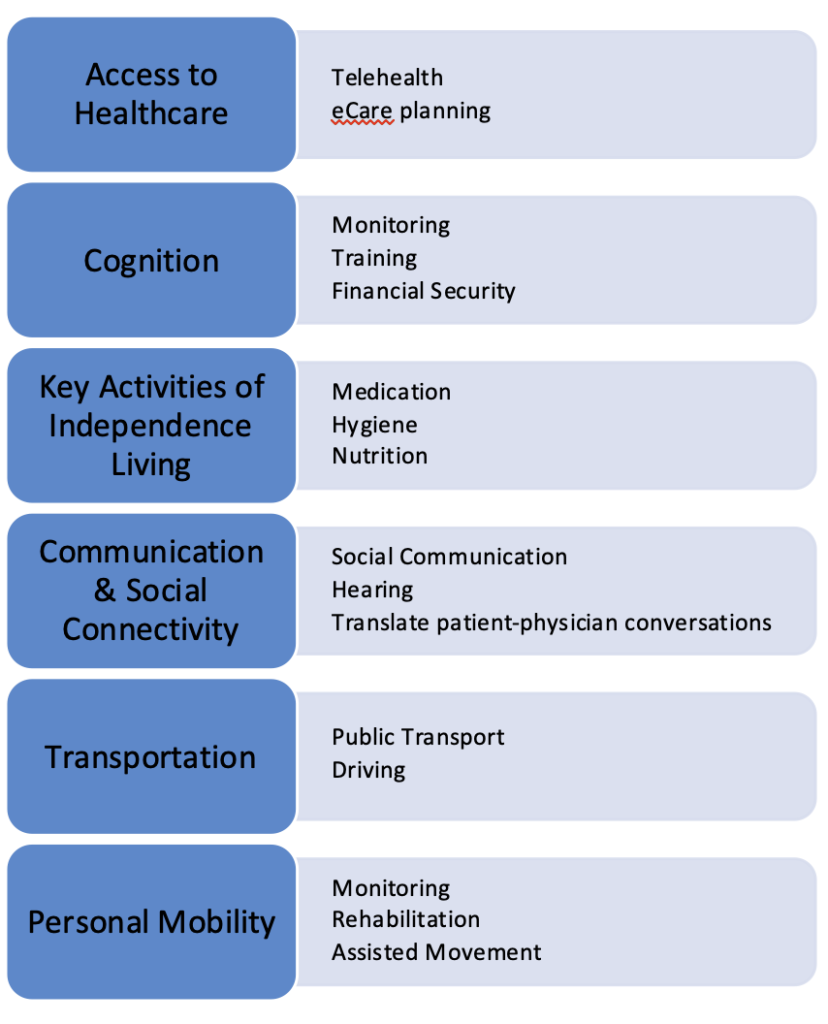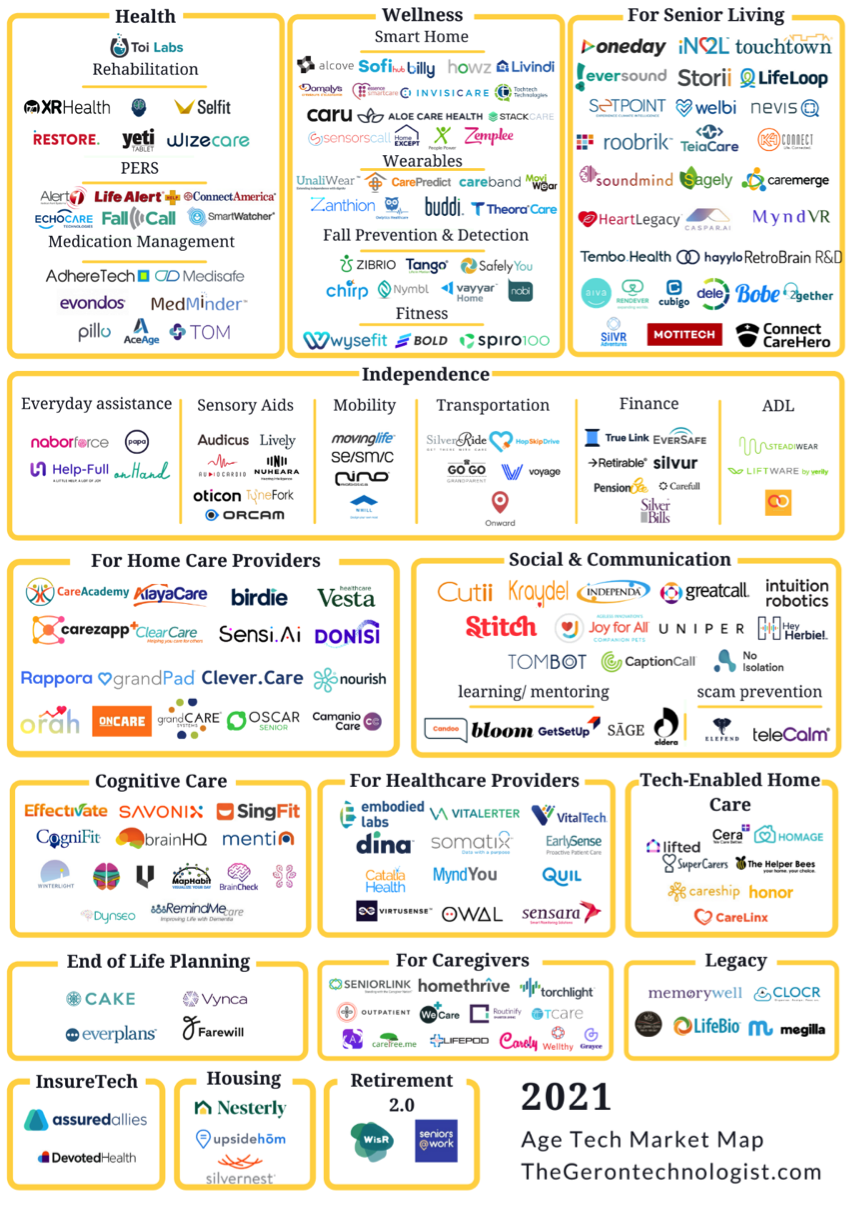Keren Etkin, cofounder of Sensi.ai recently presented an insightful and equally engaging Age Tech Market Map for 2021. Published by The Gerontechnologist, this detailed map paves the way for an in-depth discussion of the potential opportunities and challenges posed by the accelerating pace of the age tech market.
Why is Age Tech Gaining Momentum?
With demographic shifts pointing towards a growing proportion of older adults, investing in ‘age-tech’ is becoming more profound.
- Presently, there are approximately 1 billion people over the age of 60 worldwide. By 2050, this is expected to grow to approximately 2 billion older adults representing 20% of total world population.
- In the US, the proportion of older adults will outnumber children by 2034.
Expanding Care Gap
With an aging population, countries are faced with a caregiver shortage. Households are collapsing under the ‘caregiver burden’. According to AARP Public Policy Institute, this growing care gap is emphasized by the statistics below:
- In 2010, there were 7.1 potential family caregivers for every person 80+.
- By 2030, it is expected that there will be 4.1 potential family caregivers for every person 80+.
Greater Preference for Aging in Place
Despite the mounting care gap, most older adults still desire to age in place. Aging in place implies having healthcare and social support, along with care services, in place for older adults to live safely and independently in their home or community for as long as they are able. While aging in place becomes particularly challenging for the elderly over time, technological interventions can ensure that older adults can stay in the comfort of their own homes and community for as long as possible.
Growth of the Longevity Economy
The ‘Longevity Economy’ is defined by the AARP as the sum of all economic activity serving the needs of older adults. The recent statistics, from the US, elicit the growth and potential of this sector:
- In 2018, Americans over 50 spent $7.6 trillion on goods and services. By 2050, this is projected to grow to $27.5 trillion.
- By 2030, these individuals are predicted to spend over $200 billion per year on digital technology products.
- Older adults are the fastest growing category of e-commerce shoppers.
Inclusive Age Tech
To cater to this accelerating sector, present technology solutions are not solely focused on meeting the needs of the older adults. They are also focused on engaging them thoroughly in the design process. Moreover, besides older adults, their entire caregiver circle is being recognized as a crucial stakeholder. This encompasses family members, governments, healthcare and other service providers, who purchase tech-based products and services, to better serve the aging adults.
Challenges of Aging:
According to Age-Well, older adults are faced with the following challenges:
- Staying connected
- Financial wellness & employment
- Healthy lifestyles and wellness
- Mobility and transportation
- Supportive home and communities
- Healthcare and health service delivery
- Autonomy and independence
- Cognitive health & dementia
However, these challenges are mitigated through adopting age technology solutions. As per The White House, Office of Science & Technology, there are six functional capabilities for which technology can yield positive impacts.

COVID-19 has undoubtedly unmasked some of the key challenges faced by our elders today. Ms. Etkin in her overview details some of the most urgent “blockers” which are truly hindering the older adults’ access to care and further deteriorating their quality of life.
- Connectivity lies at the centre of all technology solutions. However, there are many cases where high speed internet is unavailable, such as in remote areas, which leads to an automatic exclusion from the virtual care net. Furthermore, currently, 22 million older Americans are still not online due to security concerns or lack of digital literacy, which presents an even wider care gap.
- Device setup is another major barrier to adoption, even for those connected to the internet.
- Since many older adults do not have the monetary resources for all their retirement years, it is pertinent to develop solutions that will be cost-effective for them in the longer-run.
- Targeted solutions need to be in place that address the caregiver shortage. Faced with increased workloads and lower pay, these caregiver roles suffer massively from worker turnover, diminishing the quality and quantity of care.
How can SenSights.AI Address These Challenges?
To enable better digital health accessibility, LocateMotion has developed SenSights.AI, an easy-to-use cognitive health & well-being intelligence platform for seniors & caregivers. It aims to track the progress of early cognitive decline by capturing vitals, daily notes, medication effects, feelings, behaviour, and finally assessing virtual interventions based on risk-levels.
To cater to the challenges of aging identified above, this unique digital solution offers 24/7 remote patient monitoring, personal emergency interventions, access to physicians and data collection. This increases patient and caregiver engagement and knowledge about mental health (especially during the decline stage) and related modifiable factors, improving healthy living behaviours and potentially delaying dementia progression in high-risk populations.
To address the device set-up barrier, as highlighted by Karen Etkin, SenSights.AI has developed a device-agnostic platform, which allows the flexibility to choose from a wide range of FDA-compliant devices to effectively monitor, and provide affordable and timely service to patients, in the comfort of their homes.
Most importantly, by recognizing the immediate need to counter the caregiver shortage, SenSights.AI’s platform offers telehealth services that help at-risk providers, home health, skilled nursing, long term entities increase their capacity by complementing virtual care with physical visits.
Book a demo today to learn more about SenSights.ai and how our proactive monitoring solutions can work for you at Sensights.ai/demo
Follow us on LinkedIn at @LocateMotion for more updates.
Contributors: Mariam Javed, Nauman Jaffar.

